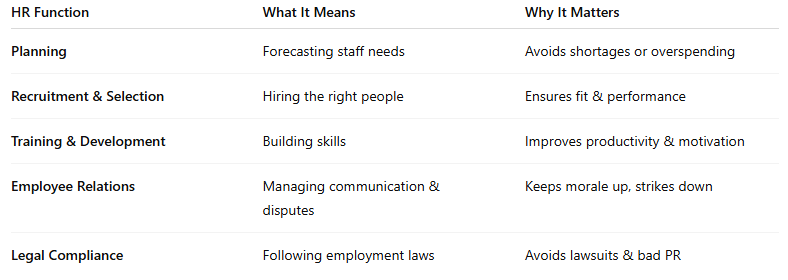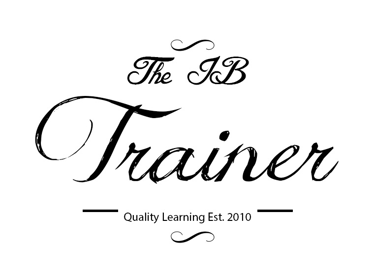People, Not Robots: What Human Resource Management Means
Discover what HRM really means - from hiring to motivation - with stories and real business examples for IB Business students.
IB BUSINESS MANAGEMENT MODULE 2 HUMAN RESOURCE MANAGEMENTIB BUSINESS MANAGEMENT
Lawrence Robert
10/12/20254 min read


Let’s Be Honest…
Imagine walking into your local Greggs for a sausage roll and no one’s behind the counter. The ovens are on, the pastries are ready - but there’s just… silence.
Machines can bake, sure. But who smiles, chats, applies emotions to the context and remembers you’re “the cheese & onion pasty person”? That’s the human side of business - the bit robots can’t do (yet).
That’s why every company needs Human Resource Management (HRM) - the slightly fancy name for the people who make sure a business has the right humans doing the right things at the right time.
What’s HRM in Simple Terms?
At its core, HRM is about managing an organisation’s people so it can actually achieve its goals - whether that’s selling sausage rolls, electric cars, or AI chatbots.
But HRM isn’t just about hiring or firing. It’s a strategy for how people are used, developed, and supported.
Here’s what HR managers actually do (in human language):
Plan ahead: Figure out how many workers they’ll need and what skills those people should have.
Recruit and select: Write job ads, shortlist candidates, and choose the best fit (and ideally not the one who just says “I’m a perfectionist” in every interview).
Train and develop: Help employees get better at their jobs, stay motivated, and prepare for promotions.
Handle relationships: Keep staff and managers from going to war - deal with complaints, conflicts, and motivation issues.
Stay legal: Make sure no one’s breaking labour laws (think equal pay, discrimination, or working hours).
Why HRM Isn’t Just ‘Admin Stuff’
HRM is what turns a group of people into a team with a purpose.
IB Business Management Real-life example: Google - their HR team (or as they call it, “People Operations”) studies data on what makes employees happy and productive. They didn’t just decide to throw free food and flexible working around randomly - what they give you it’s based on HR research.
IB Business Management Real-life example: Greggs again. Their HR policies - like sharing profits and promoting from within - are why their staff actually smile while serving you at 7 a.m. That’s no small feat or achievement.
IB Business Management Real-life example: Even Pret A Manger gets it. They built their brand on friendliness and teamwork. Employees nominate each other for rewards. HR made that happen - by turning kindness into part of the company culture.
Where This Fits in IB Business Management
In your IB Business Management course, HRM links to nearly everything:
Paper 2 & Paper 3 often include HR issues - motivation, recruitment, training, or labour laws.
HR decisions also affect other units: marketing (customer service), operations (productivity), and finance (costs).
So, whenever you see a case study about people being hired, trained, or striking for better pay - you’re in HRM territory.
An HRM Framework You Can Actually Remember
Here’s a little mental map you can screenshot or scribble down:
HRM & The Law
In the UK, The Equality Act 2010 protects employees from discrimination based on things like age, gender, race, or disability.
It might sound dull, but this law costs businesses millions when they ignore it. Remember the Asda and Tesco equal pay cases? Their HR departments had to rethink pay structures because women in stores were being paid less than men in warehouses - for comparable work.
Moral of the story? HRM isn’t just about hugs and high-fives - it’s about protecting the business from bad headlines and huge fines.
HRM in the Real World (In 2025)
Fast-forward to now, and HRM has levelled up. The modern HR manager isn’t just sorting holiday requests - they’re part strategist, part therapist, part data analyst.
Here’s what’s hot in HR right now:
AI recruitment tools (like HireVue and LinkedIn Recruiter) helping screen applicants - though bias is still a hot debate.
Hybrid working becoming normal - most firms are still experimenting with “3 days in, 2 days out” models.
Mental health support now mainstream - Unilever, Lush, and Salesforce offer mental health days and wellness budgets.
Green HRM emerging - linking HR policies to sustainability, from cycle-to-work schemes to carbon-neutral offices.
Common IB Business Management Student Mistakes
NO Saying “HRM is about hiring and firing.”
YES Saying “HRM is about using and developing people to meet strategic goals.”
NO Forgetting to connect HR decisions to the business objectives.
YES Explaining why HR actions (like training) matter for things like productivity, profit, or reputation.
NO Listing theory without real-world examples.
YES Dropping in case studies - even quick ones like “Greggs promotes from within” or “Google’s People Analytics team boosts productivity.”
Exam Gold
Here’s what you need tattooed in your IB Business Management brain:
HRM = Managing people strategically (not just admin).
Functions = Plan → Hire → Train → Support → Comply.
Real examples = instant brownie points.
Always link to strategy: How does HR help the business grow, cut costs, or compete?
Final Thought for your IB Business Management Course
Machines might make our coffee or deliver our parcels, but only people can make a company worth working for.
Behind every smiling Pret employee, every happy Greggs baker, every over-caffeinated Google coder - there’s HR quietly pulling the strings, planning the next move, and keeping the whole show running (more-or-less) smoothly.
That’s human resource management: business, but with a heartbeat.
Stay well,


IB Complete Support Courses, a new generation of affordable support materials directed at IB students seeking grades 6 or 7.
© Theibtrainer.com 2012-2025. All rights reserved.
